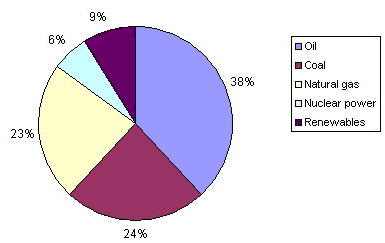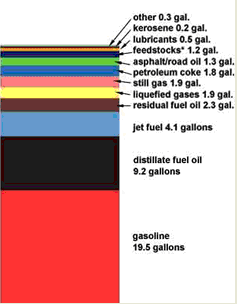Fossil Fuel Depletion
Summary | What
are fossil fuels? | Their Use | The
crisis | The future | References
| Link
|
G.Ferraiolo, C.Mascolini,
N.Pecoraro (*) I.Ionita (**) - Linguistic Mediator: E.D'Acunto (*)
|
|
(*) Istituto Alfano
I - (**) University of Galati
|
Summary
Events as the electrical power crisis in California during the summer of
2001 drew world attention to a shortage of crude oil and natural gas. Fossil
fuels are currently the primary source of the cheap energy that powers our
modern Industrial Civilization. If we are running out of crude oil and natural
gas, as some of the best scientists and engineers in the energy field are
telling us, we will have big problems. Fossil fuels take millions of years
to make. We are using up the fuels that were made more than 300 million
years ago. Once they are gone they are gone.
What are fossil fuels?
Better, what do you believe they are? Maybe you think they are substances
produced continuously by some mysterious geological forces in the depth
of the earth? Not at all! They are not inexhaustible energy sources! We
must be aware that oil and other fossil fuels, whereupon our present civilization
is founded, are going to be depleted very, very soon.
Fossil fuels, also known as mineral fuels, are hydrocarbon-containing natural
resources such as coal, petroleum and natural gas. Fossil fuels take millions
of years to be produced. The solar energy that vegetation captured by photosynthesis was slowly transformed by geological processes into coal, oil, and natural
gas.
 |
The origin of oil. |
The picture illustrates the origin of oil. Organic matter of biological
origin and mineral sediments are deposited at the bottom of the sea or
marshy fields, producing the so-called source rock. Oxygen dissipates.
The gradual subsidence of the source rock causes the temperature and pressure to rise. These factors, along with the action of anaerobic thermophilic
micro-organisms, slowly change the organic matter into hydrocarbons. From
the source rock, where these processes take place, hydrocarbons can pass
to contiguous rocks, the reservoir rocks, where they are stored.
Use of fossil fuels
We are using up the fuels that were made more than 300 million years
ago. After we use up this non-renewable energy source, it's gone until
natural processes create more-over a few hundred million more years.
Occasionally, during human history, somebody, somewhere on the planet,
discovered an outcrop of coal or a pool of tar. This usually involved
burning it . Mostly, the fossil fuels were untouched until 1200 AD. Then,
the people who lived in Europe's vast, dense forests had a wood-based
civilization, but extensive cutting had caused trees to become scarcer,
and some folks began to burn coal for fuel. Ever since that first oil
well punched into the earth in 1859, demand for crude oil has equalled
supply. The more oil that was pumped worldwide (an average 2-5% more each
year), the more got used. The oil-using life-style made consumers feel
richer and more comfortable-more pharmaceuticals, more plastics,
more transportation, more heat, more cooling, more entertainment. Most
of the planet's current population of 6 billion people prefer the industrialized
life-style. Also, most are now dependent on fossil-fuelled agriculture to eat.
 |
 |
Fig.2 Global energy consumption by fuel type
(2001) |
Fig.3 What’s in a barrel of oil |
The crisis
Of all the problems generated by fossil fuel use, the most challenging
will be surviving the withdrawal from that use, after worldwide oil production
peaks and begins to decline. The oil crisis will begin when demand for
oil consistently begins to exceed supply. The transition from oil-technology
back to non-oil-technology, and its accompanying labour-intensive, materially-poor
life, will begin after world oil production peaks. M. King Hubbert, an
oil scientist with a Ph.D. from the University of Chicago who taught seven
years at Columbia University, then researched twenty-five years for Shell
Oil, then years more for the United States Geological Service, repeatedly
warned that the fossil fuel era would soon be over and urged us to prepare
for that inevitable transition. In 1956, the United States was the world's
largest oil producer, supplying its own and half the world's oil.
That year, Hubbert predicted (despite efforts by Shell brass to shut
him up) that the rate of U.S. oil production in the lower 48 states would
eventually look like a bell-shaped curve, and that it would reach its
maximum, topmost peak of that curve between 1965 and 1972, thereafter
to inexorably drop, year after year. He was ignored, criticized, or denied—but
he was right. In 1970, crude oil production in the lower 48 states peaked
at 9 million barrels a day. Since then production has gradually dropped.
After Hubbert's prediction came true in 1970, he—and an increasing
number of other oil scientists, as time went on—strove to predict
the year when the world's oil supply would peak. In 1999, oil geologists
estimated that ninety percent of global oil deposits had been located.
In 2003, there were no new oil field discoveries. Years ago, based on
the oil field discovery curve, Hubbert predicted that world oil production
would peak after the turn of the century. All experts agree that world
oil production will peak before the year 2015. What happens then?
The future
We, or some generation or other of our descendants, will have to face
weaning from fossil fuels. Whenever it happens, who will do without fossil
fuel—its energy and its products? What form will that competition
take? In the best case scenario, there will be a worldwide shift from
fossil fuel technologies to a combination of pre-petroleum and post-petroleum
renewable energy technologies (we have the advantage of a century of rapid
scientific discovery)—and we do this before our planet's climate
and environment are irreparably damaged. To help us adapt to the coming
cutbacks, we can learn from people who have expertise in pre-petroleum
technologies: use of draft animals, natural gardening, cottage industries,
as well as renewable energy experts. The bad news is that even the best
of combined pre-petroleum and renewable energy technologies cannot produce
the lavish amounts of energy we're accustomed to using.
Here (fig.4 and 5) is the probable future may bring to the U.S. after
Hubbert's worldwide peak, in accordance with the Olduvai theory ( Duncan
1989).
|
Fig.4 - Estimation of per capita energy use
vs years |
As shown in the picture, the life-expectancy of Industrial Civilization
is less than one-hundred (100) years, if Industrial Civilization doesn't
evolve. The following phases can be considered:
- Pre Industrial Phase (c. 3 000 000 BC to 1765)
- A - Tool making (c. 3 000 000 BC)
- B - Fire used (c. 1 000 000 BC)
- C - Neolithic agricultural revolution (c. 8 000 BC)
- D - Watts steam engine of 1765 Industrial Phase (1930-2025)
- Industrial Phase (1930 to 2025, estimated)
- E - Per capita energy-use 37% of peak value
- F - Peak energy-use
- G - Present energy-use
- H - Per capita energy-use 37% of peak value
- Post Industrial Phase (c. 2100 and beyond)
- J, K, and L = Recurring future attempts at industrialization fail.
Other scenarios are also possible.
|
Fig.5 The Olduvai theory ( Duncan 1989) |
The Olduvai theory ( Duncan 1989) states that the life-expectancy of
Industrial Civilization, defined in terms of world energy use per capita
(e), is less than or equal to 100 years. “HISTORY”: We know
that the peak of (e) occurred in 1979 and that (e) declined from 1979
to 1999 (the 'slope'). “FUTURE”: The Olduvai theory predicts
that (e) will decline even faster from 2000 to the so-named 'cliff event'
(the 'slide'). The 'cliff event' is forecast to occur in year 2012.
References
The Olduvai Theory: Sliding Towards a Post-Industrial Stone Age, by Dr.
R. C. Duncan, July 1996 Link

http://www.archiviostampa.it/it/articoli/index.aspx?c=1503
http://www.aspoitalia.net/documenti/bardi/petroliointroduzione/petroliointroduzione.htm
http://www.bfsf.info/wws/d_read/bfsf/Documenti/crisicheverra.pdf
http://www.carta.org/rivista/settimanale/2004/01/01GubbiottiPesacane.htm
http://www.ecoage.it/petrolio-ottocento.htm
http://www.energoclub.it/a/petrolio.htm
http://finanza.espressonline.it/scripts/cligipsw.dll?app=KWF&tpl=kwfinanza%5Cdettaglio_news.tpl&del=20051207&fonte=LFN&codnews=43217
http://www.lenntech.com/italiano/Effetto-serra/combustibili-fossili.htm
http://www.minerva.unito.it/Epistemologia&Etica/CrisiUomoNatura/Crisi5.htm
http://www.storiadimilano.it/citta/milanotecnica/strade/asfalto.htm
http://ulisse.sissa.it/Answer.jsp?questionCod=118751355
http://www.vasonline.it/home/editoriali/petrolio
http://www.wwf.it/lavoro/campagne/clima/documenti/Cambiamo%20Energia.pdf

http://www.carlaemery.com/fossil-fuel.htm
http://dieoff.org/
http://www.energyquest.ca.gov/story/index.html#table
The Energy Story - Chapter 8 Fossil Fuels - Coal, Oil and Natural Gas.htm
http://solutions.synearth.net/stories/storyReader$8
Top - Previous
Module - Next Module
|






